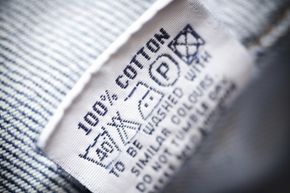 “What does this even mean?!knape/E+/Getty Images
“What does this even mean?!knape/E+/Getty Images
In our daily lives, we’re surrounded by symbols meant to guide us, warn us and convey concepts quickly. From the diamond-shaped hazardous-materials placards on tractor-trailers, rail cars and cargo containers to the glyphs and emoji on our cell phones, ours is a semiotic world, awash with signifiers ranging from the elegant to the enigmatic.
Not surprisingly, clothing care symbols — those squares, circles, tringles, swooshes, lines and dots on the labels of almost everything we wear — fall somewhere in between. After all, as anyone who’s played Pictionary can attest, we don’t all share the same ideas of what makes for an effective symbol. One person’s "baby talk" is another’s "baby fish mouth." Old movie references aside, clothing-care symbols are a code worth knowing, whether you’re washing your duds or deciding whether buying that angora sweater is really worth the aggravation.
As near as we could find out, clothing care labels in America date back at least to the 1950s. They gained steam in the 1960s but didn’t become federally regulated until 1983 [sources: FTC, Michael]. Today, most clothes and fabrics require labels (exceptions include gloves, hats and shoes) [source: FTC]. Typically, an apparel company sends tag designs with care info to a label supplier, which turns out the labels and sends them back for approval. From there, they go to the contractors who cut and sew the garments [sources: Flores, McGuire, Michael].
All well and good — but where did the symbols come from in the first place? Turns out, the symbols we use today are a rather recent development.
"In the late ’90s to early 2000s the American Society for Testing and Materials, ASTM International, put out a standardized set of care symbols with the goal of creating a universally understood set," said Adam Flores Jr., technical service manager at Progressive Label Inc.
If you’ve ever looked at these tags, you’ve perhaps noticed they can differ quite a bit. Some have more symbols, others fewer; some sport text, symbols or both. So what gives? Well, the Federal Trade Commission (FTC), which enforces label rules in the U.S., doesn’t mind a little efficiency, as long as the message gets across. So if your label simply says, "Machine wash. Tumble dry," (and nothing more) then feel free to wash and dry at any temperature, using any bleach you like, without worrying about ironing or special treatment [source: FTC].
That said, the rules do try to prevent likely mix-ups — such as assuming a machine-washable garment is OK to iron — as well as consumer fraud [sources: Flores, FTC].
"Companies providing the care information have to have a reasonable basis for the information they disclose, which they develop from testing, experience with similar garments, information from the mills, etc.," said Catherine Michael of the American Apparel & Footwear Association.
Let’s take a closer look at those symbols and what they mean.


